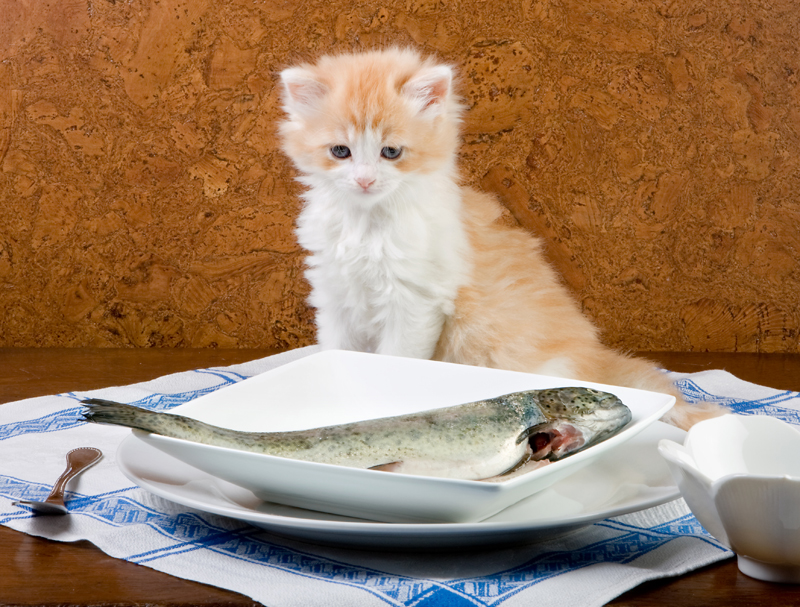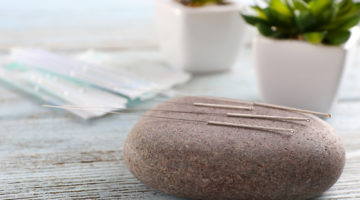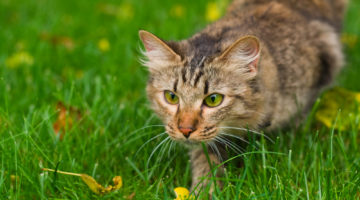It involves more than just chopping up some meat. Ensuring home-prepared diets provide cats with the nutrients they need means learning something about feline nutrition.
After one of my animals fell ill with a gastrointestinal upset that the vet couldn’t get to the bottom of, I decided to change what I was feeding my cats and dogs. I became almost fanatical about studying labels, and decided it was time to get out my pots and pans and cook for my companions.
Preparing whole food home-prepared diets isn’t rocket science. It can be as simple as selecting foods from a “take out” menu of proteins, fats and carbohydrates, and determining the amount of food your cat will need to eat on a daily basis.
Get started with some homework
Before diving headfirst into home-prepared diets, you need to do some research on nutrition for cats. The following resources are especially helpful:
- Two books are always front and centre on my own bookshelf, and I encourage you to get them and read them: Dr. Pitcairn’s Complete Guide to Natural Health for Dogs & Cats (3rd edition, revised and updated) by Richard H. Pitcairn DVM, PhD and Susan Hubble Pitcairn; and Home-Prepared Dog & Cat Recipes: The Healthful Alternative by Donald R. Strombeck DVM, PhD. These two tomes are easy to read and understand, and packed with valuable information and recipes.
- Your Cat’s Nutritional Needs: A Science Based Guide for Pet Owners is a free online booklet published by the National Research Council of the National Academies. It contains information about proteins and amino acids, fats and fatty acids, energy needs, vitamins, minerals, feeding practices and food choices. Easy-to-read charts provide you with a framework for diets to meet the individual needs of your feline companion, along with guidance from veterinarians and nutritionists.
- Check out the USDA database at nal.usda.gov/fnic/foodcomp/search and nutritiondata.com. You can do analyses of countless foods, including caloric content, and work out percentages of protein, carbohydrates, fats, vitamins and minerals based on serving size. Or check out the world’s healthiest foods at whfoods.org. Another good resource is “Nutrient Requirements of Dogs and Cats” from National Academies Press at books.nap.edu/openbook.php?record_id=10668&page=R1.
Additional Tips
- It’s wise to work with a holistic vet when switching your cat to a home-prepared diet. You’ll also have to proceed slowly. Don’t suddenly start feeding your cat a new diet or he may end up with diarrhea. Gradually introduce the new food over a period of days or weeks, and monitor his response.
- Variety is the spice of life, especially for finicky felines. Mix it up for your cat, using different foods from a selection of protein sources, including fish and organ meats. Don’t worry too much about everything being absolutely balanced all the time; instead, work towards balance over time. If your cat has a health condition, you can prepare a diet that targets his specific concern; a holistic vet can help, along with Dr. Pitcairn and Dr. Strombeck’s books.
- Try to use organic foods whenever possible, and make friends with your butcher. Ask about hormone and antibiotic-free meats. Choose seasonal fruits and vegetables and whole grains.
Three-pronged Approach
Using National Research Council guidelines, let’s take a look at some of the diet possibilities available to a nine-pound cat. According to NRC requirements, he will require 250 calories per day.
The ratio for the following simple diet plan is approximately 30% protein, 40% carbohydrates and 30% fat. (The NRC recommends that kittens be fed a diet that includes 30% protein and 20% fat, while adult cats should get 25% to 30% protein, and 15% to 20% fats.)
All the foods listed below are based on cooked volume. This recipe makes enough food for five days. Keep no more than two or three days’ worth of food in the fridge, and freeze the rest in serving-sized containers.
Step #1 — Protein
Choose one protein from the list below, keeping in mind that this is simply a starting point for your homecooked diet and that you can mix and match when you have some food prep miles under your belt. Start with 1 1/2 cups of one of the following:
- Chicken
- Turkey
- Duck
- Lean beef
- Bison/buffalo
- Lamb (lean cuts)
- Venison
- Emu
- Ostrich
- Rabbit
- Salmon
- Tuna
- Pollock
- Mackerel
Step #2 — Carbohydrates
Whole grains and fruits and vegetables provide the most complete source of carbohydrates. “Because the intestinal tracts of dogs and cats are much shorter than those of cereal-eating animals, like cows and horses, grains fed to dogs and cats need some predigestion, in the form of cooking,” says Dr. Pitcairn. For our purposes, one cup of a dry whole grain is cooked in three cups of filtered water.
Select one cooked carbohydrate from the list below:
- 3 cups whole brown rice
- 3 cups whole white rice
- 3 cups pearl barley
- 4½ cups oatmeal, made from whole oats
- 3 cups sweet potatoes or white potatoes cooked without skins
Also add ¼ to ½ cup cooked vegetable and fruit mash that includes both orange and green vegetables and brightly colored fruits – for example, carrots, pumpkin, squash, broccoli, zucchini, green beans, apples, blueberries and cranberries.
Step #3 — Fat
Add one tablespoon of cold pressed oil such as safflower, sunflower, canola, grape seed, hemp, avocado, olive or rice bran.
Step #4 – Supplements
Your feline friend will also need a complete vitamin/mineral complex to round out his diet plan.
- You must include a calcium source. It may take the form of human grade bone meal, available from health food stores, pharmaceutical grade di-calcium phosphate, or vegetable based calcium. This is where careful reading of labels is so important, because each product is different. A nine-pound adult cat requires a minimum of 750mg of calcium per day.
- Cats also need taurine, an essential amino acid. Taurine deficiency can cause a variety of metabolic and clinical problems, including blindness, deafness, heart failure, inadequate immune response, poor neonatal growth, reproductive failure and congenital defects. Speak to your veterinarian or nutritionist about taurine supplementation for your cat.
Once you have a healthy and complete diet plan in place, with the help of your vet and the resources listed in this article, you’re off to the races. Have fun – and watch your cat thrive!
Very Best Chicken Stock
This nutrient-packed broth can be added to any of your cat’s recipes.
- 24 cups filtered water
- 3 pounds chicken backs and necks
- 2 carrots, in pieces
- 2 celery stalks, in pieces
- 3 Shitake mushrooms, dried or fresh
- 2 garlic cloves
- 1 piece fresh ginger
- 12 white pepper corns
- 1 to 2 tablespoons kosher salt, or to taste
- Handful fresh parsley (Italian or curly)
- Other fresh herbs to taste, e.g. thyme, oregano, sage, rosemary
Put all ingredients in a large stock pot. Bring to a boil. As soon as you have a rolling boil, skim off the foam, turn the heat down to simmer, and leave the pot to sit and stew all day. Refrigerate overnight. Next morning, skim off the fat, remove meat and vegetables, strain into storage containers and freeze.







No Comment